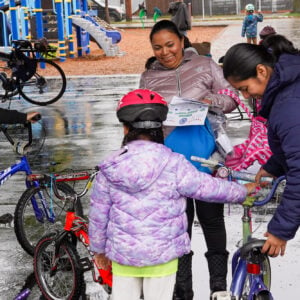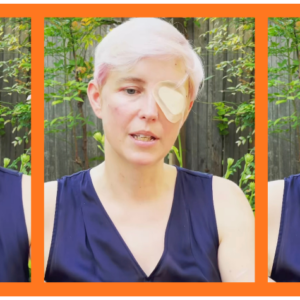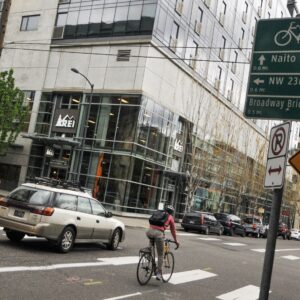
Somewhere around 5% of trips in Portland are made by bicycle. And less than 1% of local transportation funding goes to bicycle infrastructure. Clearly bicycling is a mode of transportation that more than pays for itself.
Meanwhile, cyclists’ taxes subsidize freeway and arterial projects that we don’t use much and that actually impede our ability to get around on bikes. Ditto for road maintenance that we do little to contribute to the need for.
“As bicycling grows in popularity and acceptance, politicians and the public are seeing the wisdom in investing in bicycling infrastructure and incentives.”
So why are cyclists fighting each other over our disproportionately tiny slice of the pie? Two major new cycling initiatives are in the works which may involve public funds — an employee tax credit for reimbursed bike commuting expenses, and a downtown Portland Bikestation or even better a network of them. Some critics on this site decry the projects because they do not go far enough or help enough people.
I say, let’s think bigger than that. These initiatives are the least we can do, and we can and will do more, much more. As bicycling grows in popularity and acceptance, politicians and the public are seeing the wisdom in investing in bicycling infrastructure and incentives.
Still, we have a long way to go.
Two major local newspapers recently opined that we shouldn’t question spending 6 billion dollars for a highway bridge reconstruction — which they acknowledge will only push auto congestion southward into more populated areas. Meanwhile, every cent spent on bike lane striping and public transit (even the tram price tag pales by comparison) is vigorously questioned on local blogs and in the news.
If we want to make Portland a truly world-class bicycling city, we need to step up with constructive ideas and compelling reasons for bicyclists to be fairly represented in transportation spending and planning. Think about those 6 billion dollars proposed for the Columbia River Crossing. The money from the thwarted Mt. Hood Freeway paid for decades of projects that made Portland the place it is — a place where you can live, and live well, without a car.
We can all win here, but we have to pull together and dream big.





Thanks for reading.
BikePortland has served this community with independent community journalism since 2005. We rely on subscriptions from readers like you to survive. Your financial support is vital in keeping this valuable resource alive and well.
Please subscribe today to strengthen and expand our work.
Re “Meanwhile, every cent spent on bike lane striping and public transit (even the tram price tag pales by comparison) is vigorously questioned on local blogs and in the news”
Well, when you’re only 5% of the trips, and represent an obstacle for some of the other 95%, newspapers are going to head to where the eyeballs are.
Which just makes our task more difficult. However, we have energy on our side, plus the rising price of gas.
“I say, let’s think bigger than that.”
I say that too, Elly. Because Bike City will be built one rider at a time.
We need to be more vocal with the logical arguments, at least in those forums where people can be swayed by reason. If we represent 5% (1/20) of all trips, that means either we should question and scrutinize any road project that costs more than 20x that of a scrutinized bike project. And if a particular road project doesn’t merit scrutiny because of its costs, then neither should bike projects that cost 1/20th or less of that road project.
Assuming the various forums and venues are willing to accept reason.
Sorry, but I can’t believe that 5% of Portland’s trips are made by bike. No one would believe me if I quoted this statistic. Are you referinig to a section of Portland?
Brian E.,
5% is a good estimate.
2005 Census data puts Portland’s mode share at 3.51% in 2005.
Read my report about this here.
This figure has doubled since 2000 and I’m sure it has risen in the last two years.
Also, census data is well-known to skew low for bike mode share.
Bikes are difficult to get hard numbers on… but I think 5% is a very solid guesstimate city-wide.
And yes, in some sections (like inner SE), you have dramatically higher percentages.
Wow, now you have me thinking about it.
In Metro’s recent MTIP exercise (http://www.metro-region.org/article.cfm?articleid=19681), $45 million was assigned to local transportation projects. $3.6 million of that went to bike trails and boulevards. So we’re getting our “5 percent” and then some. Is that enough? Heck no, but at least we’re above the mode split as far as that pot of funds is concerned. The level of funding was determined in no small part because of public support for these projects.
Generally, I think there’s a lot more acceptance of cycling around Portland than the blogs would lead you to believe. There are a few (dozen or less) people who dominate the anti-bike discussion on various blogs, repeating the same tiring and well-refuted arguments against cycling (and any other mode other than cars). Also, people tend to post when they’ve had a run-in with a motorist, but never when they had a totally uneventful day on their bikes riding around town.
So, by reading the blogs, one could argue that you get a skewed view of to what level cycling is accepted. My experience is that the majority of people think more bike trips and fewer car trips is a good thing, even if they don’t actually cycle themselves. A recent survey done by Metro for the Regional Transportation Plan update confirms this.
I think we’re already in a good position and that it will only improve. Fuel prices will continue to rise; concerns about global warming and dependency on foreign oil will increase as well. While the CRC staff recommends a $6 billion bridge, a group of politicians are saying that other options need to be on the table for consideration. People are riding their bikes more and more and the demand for better, safer streets for cycling will be a result.
The 5% figure is only for going to work, not for other trips. The more important number would be trip miles, since someone who bikes 1 mile would count the same as someone who biked 30. I don’t know how including non-commute trips would change the trip miles number, since non-commute trips could be much shorter, e.g., 5 blocks to the coffee shop instead of 5 miles to downtown.
The other important thing that isn’t measured is what mode cycling is replacing, since in transportation terms it doesn’t matter as much if people are biking instead of taking the bus, but it does matter if they’re replacing driving.
I also want to point out that saying “less than 1% of local transportation funding goes to bicycle infrastructure.” should rather be “bicycle specific infrastructure”, since we can use the same roads cars do. And, 1.5% of property taxes go to Trimet and MAX, which make including biking as part of transport much easier.
Metro’s MTIP…$45M…is just 4% of annual transportation spending in the region. The lion’s share is roads (ODOT) and transit (TriMet), which are split about 50/50.
Providing safe, connected, and well signed routes for bikes is a win for everyone.
Maybe its time for a $100M Bike Bond Measure to really build out the system. It would be a powerful mandate to Metro, the City and the State to crank things into high gear.
How about crafting a statewide referendum that would give local jurisdictions the OPTION of setting aside 2% of their share of overall gas tax revenues for non-highway construction uses like transit, bike facilities, etc. There’s a constitutional prohibition against using gas tax revenues in this way in OR and many other states, thanks to the road/auto/gas lobby, but a referendum that gave locals the option to divert a small piece of the gas tax piggybank for transit and bikes might fly. The key, I think, would be to diffuse the opposition by making it optional, and giving local government the power.
That is a very good point in number 10 by Steve G. When I sat on Corvallis’s Citizen’s advisory committee on transit we often had people come in and testify that it would be good if we raised gas taxes a few pennies a gallon and used it to improve transit in and around the Corvallis metropolitan area, and we would always have to explain to them that we could not legally do that. If we could have I think corvallis would have.
Bjorn
In Oregon all public buildings that are built require that at least 1% of the building cost be used for art installation at that new building. You can read more about it here: http://www.oregonartscommission.org/public_art/percent_for_public_art_program.php
So how about creating a similar system on the local level (city or county?) requiring a percent (1 to 5%) of funds used for road construction be used for bike related transit?
Matt,
Would this be in addition to the state funds available under ORS 366.514?
See paragraph (3)
http://www.orcities.org/Portals/17/A-Z/ORS/ORS366.514.html
I’m waiting for five-dollar gas. Nothing like some cold, hard reality to break loose and re-shape formerly fossilized thinking.
A few notes:
MTIP – The money has been assigned, but not yet spent, so we don’t know the final figures yet. Projects have a way of coming under or over budget. MTIP only represents Metro’s spending, anyway, not ODOT’s, or Portland’s, or county spending. Portland spends about 1% of its transportation budget on bicycle-specific projects according to Sam Adams (PSU Transportation class lecture, November 2006).
Bike Boulevards are funded by the city, major road improvements by ODOT. There are some exceptions. MTIP money goes to specific projects. County money goes to non-urban roads – this doesn’t affect most of us, but some (like me) who live in unincorporated Washington County, or those on the non-incorporated west-side areas have to deal with non-Portland, non-ODOT roads.
Work trips – the number is between 4% and 7%, depending on whose numbers you believe. Bridge trips are now above 12,000 per day. The average bike trip is probably about 2-3 miles, though I don’t have hard numbers on that. The average car commute in the US is 20-30 miles (IIRC, Portland is 21 miles), and the average non-commute trip by car is probably no more than 5 miles. People now use their cars to go exceptionally short distances.
I think work commuters are probably a better measure than road-miles. No one cares about road miles except from a road-replacement standpoint (i.e. cost) – they care about congestion. Taking 10-12k cyclists off the road and putting them into cars during the morning and evening commute would definitely be noticed. In all likelihood it would paralyze a lot of the Portland area – the road network is very near capacity in many key areas and upping the traffic a few percent would have a huge effect. An increase in road utilization from 45% to 50% is trivial, but an increase from 85% to 90% makes accidents more likely and increases overall travel time disproportionally.
Bill,
I don’t really know much about the existing system for funding bike projects, but obviously there is some system for funding in places. My guess is that much of it is attached to federal funding for larger road projects? I was simply tossing out an idea to see what kind of response other more knowledgeable folks (like yourself?) might think.
Here is another idea: How about an addtional gas tax per gallon to finance bike projects? A few cents extra per gallon? I think these taxes are done at the state and city level?
Seems relevant to the discussion, these aer the average trip lengths used in regional models.
Average Trip Distance (miles) by Mode and Trip Purpose
1994-95 Household Activity Survey
for weekday travel by households in Clackamas, Clark, Multnomah, and Washington counties
Walk Bike Transit (walk acc) Transit (P&R acc) Auto (SOV) Auto (HOV)
Home-Based Work 1.0 4.7 6.3 11.6 8.4 7.6
Home-Based Shop 0.9 1.7 3.8 4.1 4.9
Home-Based Recreation 1.0 1.8 4.3 5.7 5.8
Home-Based Other 1.0 2.0 4.8 5.0 4.9
Non-Home-Based Work 0.9 1.6 5.1 5.8 5.1
Non-Home-Based Non-Work 1.1 1.7 4.1 4.3 4.4
Home-Based College 1.0 2.2 7.7 7.4 5.1
All Purposes (incl. School) 1.0 2.0 5.3 10.3 6.3 4.9
Matt M,
I’m not sure I really understand the correct interpretation of the statute, but it seems, to me, to say that the 1% figure is a minimum and that city or county expending the funds could increase that amount.
from the statute:
(3) The amount expended by the department or by a city or county as required or permitted by this section shall never in any one fiscal year be less than one percent of the total amount of the funds received from the highway fund. However:
(a) This subsection does not apply to a city in any year in which the one percent equals $250 or less, or to a county in any year in which the one percent equals $1,500 or less.
(b) A city or county in lieu of expending the funds each year may credit the funds to a financial reserve fund in accordance with ORS 294.525, to be held for not more than 10 years, and to be expended for the purposes required or permitted by this section.
(c) For purposes of computing amounts expended during a fiscal year under this subsection, the department, a city or county may record the money as expended:
(A) On the date actual construction of the facility is commenced if the facility is constructed by the city, county or department itself; or
(B) On the date a contract for the construction of the facilities is entered with a private contractor or with any other governmental body.
I believe that it would be easier to get a local spending authority (city, county) to increase the spending level for bike facilities from existing funds than to institute new taxes. Past efforts, at the state level, to increase the gas tax, to make up for maintenance revenue shortfalls due to better vehicle fuel efficiency, have not been successful at the ballot box.
I think we should try to get the local politicians to cut us a larger slice of the pie that is already on the table. This would give residents of the Portland Metro area a way to fund the bike facilities they want while not requiring residents of Birkenfeld to pay for something they cannot use.
Be careful what you wish for! While I am in favor of more bike related monies, I do see the day when there are enough bikes on Oregon’s roadways that some legislators craft a plan (licensing, tags, mandatory accident / liability /theft insurance, required safety classes at DMV, tire tax, stepped up rule enforcements, etc.) to make us pay for “our fair share”.
Eventually we will become a revenue target just like drivers.
While I think transport funding should include investments in bicycle-friendly infrastructure…I feel like the adult cycling community focuses too much on the car/bike divide.
In Portland, one thing that I don’t hear talked about (and would like to) is cycling outreach to school-aged children. Do schools support students who ride their bikes to school? Adequate covered racks, storage for extra gear (helmets, panniers). In this bike-friendly town, Portland has an opportunity create new responsible cyclists while they are young and car-less!
Re: cycling outreach to school-aged children
The Bicycling Transportation Alliance (www.bta4bikes.org) and the Community Cycling Center (www.communitycyclingcenter.org) both have strong programs in educating elementary-school children about bicycling and bike safety–bike camps, workshops, youth bike rides, etc. If you’re interested, I’m sure both of these organizations could use more volunteers to help keep these programs going and even expand them to more children and more schools.
Brad — I long for the day when there are enough cyclists on the road to make bicyclists a target for revenue building! As it is, I’ve heard that a bike registration system would be unable to pay for itself. Right now bicyclists support other infrastructure through our income taxes; these things you mention won’t happen until our mode share is so large that the population of cyclists no longer can pay for the expanded infrastructure we need, at which point, I’d be thrilled to pay my 30 bucks and display my sticker.